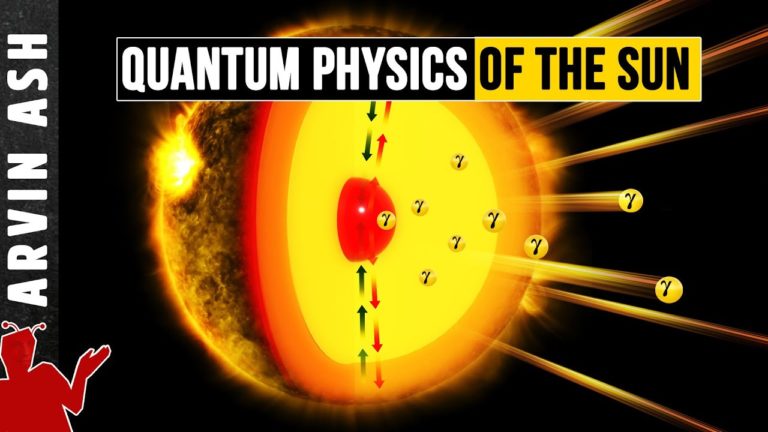Why does the SUN SHINE? The Quantum Explanation for How the Sun Works
The mass of the sun was well understood, and translates to about 10^57 atoms. This leads to a lifetime of the sun of about 20,000 years. But we know the sun is at least 4.5 billion years old. So where does the sun’s energy come from? from: E=MC^2, which tells us that energy and mass are equivalent. If the sun could convert all its mass 2 x 10^30 kg to energy, it would burn for 15 trillion years!
But the sun doesn’t convert all its energy to mass. It converts only about 0.7 percent of its mass to energy in a process called fusion. This is when 4 hydrogen atoms fuse to form one helium atom. And using this process, the sun will last approximately, 10 billion years. It is already middle aged.
So how does fusion work? You would think that since the protons that make up the nuclei of the 4 hydrogen atoms are positively charged, they would repel each other. This is true, due to the coulomb force. This is what keeps atoms from spontaneously fusing.
The protons have to overcome an energy barrier. Once they get over this barrier, and get very close to each other, the strong nuclear force takes over and glues them together.
The strong nuclear force is about 100 times stronger than the electromagnetic force pushing protons apart, but it acts at only a very short range – about the width of the proton. So how do the protons get close enough for this to happen?
Inside stars extreme temperature, about 15 million degrees Celsius, rips atoms into their components: protons, neutrons and electrons. Extreme pressures also force these components to be close together. This gets fusion started, but to keep things going, the sun uses quantum tunneling. This is due to the uncertainty principle in quantum mechanics.
In the hydrogen to helium fusion process, first two protons fuse. Usually, the pair breaks apart again immediately, but once in a while one of the protons is transmuted into a neutron. This happens due to the weak nuclear force in a process called beta decay. A neutron turns into a proton by releasing a positron (anti-electron) and a neutrino. The resulting proton-neutron pair is deuterium.
When the positron emitted from the beta decay encounters its antiparticle (an electron), the pair annihilates to form a gamma ray, which is the most energetic form of photons. Gamma rays eventually work their way up from the core of the sun and out into space in the form of sunlight. The deuterium nuclei can merge to form helium nuclei (He-4), or they can interact with other protons to make another isotope of helium (He-3). Two He-3 nuclei can fuse to make an unstable beryllium nucleus (Be-6) that breaks apart to give He-4 and two protons. Energy is released at each step.
So overall, we start with 4 hydrogen nuclei, or 4 protons, and end up one Helium nucleus, or 2 protons and 2 neutrons. This is really a fusion of our 4 original protons. Two of them have just transmuted to neutrons in a beta decay.
Energy comes from mass being converted to energy. 2 neutrons and 2 neutrons separately weigh more than when they are together, about 0.7% more. And this difference is responsible for nearly all the energy that you see coming from the sun.
Helium has higher binding energy than Hydrogen, which is the amount of energy needed to pull the nucleons apart. Hydrogen has zero binding energy because there is only one proton in the nucleus. There is nothing to pull it apart from. The difference in binding energy between Helium and hydrogen is the source of the energy released in the fusion process.
Why are the 4 nucleons of helium more stable together than when they are separated apart? Most of the mass does not come from the Higgs field. Only about 1% of the mass is due to the Higgs field. 99% comes from the strong force. The energy required to keep protons and neutrons bound together and keep the quarks bound to within the nucleon is where most of the mass of objects is located.
The helium atom with 4 nucleons is more stable than the nucleons on their own. That is the quantum mechanical explanation of why the sun shines.
Do not forget to share your opinion with us to provide you with the best posts !




0 Comments